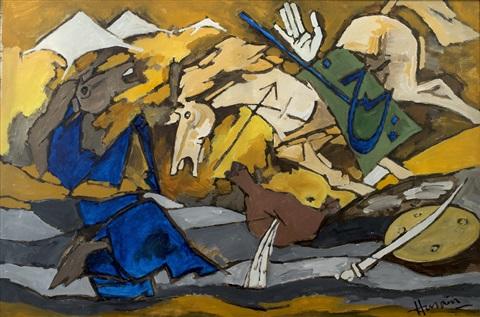The 'Battle of Karbala' has held existential importance in a wide variety of cultural spheres in which Muslims participate. As a single most significant historic event in the lives of millions of Muslims, Karbala has left an indelible symbolic mark on devotional practices, on the transmissions of Islamic history, and subsequent developments in aesthetics, mysticism, and reform movements throughout the Muslim world.1
Consequently, it made a significant impact on the development of young M.F. Husain and helped mold his consciousness, beliefs, and outlook both in his art and personal life as a Shia Muslim.
According to Artiana.com, the historic battle was fought between the Ummayad caliph Yazid 1 and Husayn ibn Ali, the youngest of the Prophet's (PBUH) grandsons, in 680 CE over the crisis of succession in the caliphate. Yazid's appointment as successor was widely contested and deemed unjust, leading to the battle as depicted by the artist here.
Arrows are seen volleying between two horses engaged in a heated battle - representative of the two combatant forces. The powerful beasts, shown without hooves as part of Husain's visual language, are poised in a duel across the center of the frame. Husain used coarse lines reflecting movement, energy, and giving the overall composition a dynamic quality. He also used a somber palette of brown and grays - evocative to the grimness of war and the ensuing mayhem and turmoil it brings, a testament to the artist's virtuosity in skill and vision. Also present in the picture are the mudra and the legendary sword Zulfiqar which Imam Husayn acquired from his father and fought with.
The aftermath of the fateful battle changed the course of Islamic history; Husayn was martyred in the plains of Karbala, along with most of his family and followers.
Once a year during Muharram, the religious commemorate this martyrdom and would carry tazias or effigies of Husayn's faithful horse in a procession through the streets. An event the artist witnessed when he was merely fifteen and would give him the biggest inspiration in portraying the equine figure throughout his artistic career. "[...] He was to remain loyal to that icon; it never strayed far from his imagination in his subsequent paintings."2

